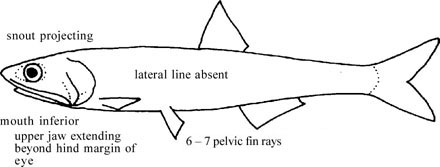ENGRAULIDAE
Anchovies
By Tetsuo Yoshino
 Stolephorus indicus |
|
|
Small to medium-sized fishes (mostly less than 20 cm, some larger) with silver-colored, fusiform or slender body. Mouth inferior; snout projecting beyond tip of lower jaw; jaw articulation well behind eye; upper jaw with 2 supramaxillae; teeth on jaws absent or minute, rarely with canines. Fins without spines; dorsal fin short and single, situated near midpoint of body, far forward in Coilia; anal fin mostly short, less than 25 rays, but long in some (to over 100 rays); pectoral fins set low on body; pelvic fins abdominal usually with 7 rays; caudal fin deeply forked, but small and pointed in some. Body covered with cycloid scales; scutes often present along abdomen; lateral line absent.
Similar families occurring in the area. Engraulidae different from other clupeoid families in having projecting and pig-like snout, slender lower jaw, and jaw articulation well behind eye. Chirocentridae: body highly compressed and elongate; no abdominal scutes; jaw articulation vertical below eye; jaws with developed fang-like canine teeth. Clupeidae: snout not pig-like and projecting; jaw articulation anterior to vertical below eye. Pristigasteridae: snout not pig-like and projecting; lower jaw projecting; jaw articulation anterior to vertical below eye. Remarks. Schooling fishes found in marine coastal areas, mostly feeding on small planktonic animals and plants. Small but important food fishes used as fresh, dried, or salted ones, taken by beach seine and other variety of nets. Regionally some species have great contribution to local catches. |

|
|